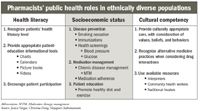Public health approaches in ethnically diverse populations
As America's diverse population continues to grow, disparities in healthcare delivery have become more prevalent. Studies show that when it comes to healthcare benchmarks, many racial and ethnically diverse populations are at a disadvantage

Key Points
As America's diverse population continues to grow, disparities in healthcare delivery have become more prevalent. The U.S. Census Bureau projects that the U.S. population will increase by 50%, from 263 million in 1995 to 394 million in 2050, with racial and ethnic minority populations accounting for nearly 90% of the increase in the overall U.S. population.1 This shift in demographics makes these disparities a pressing matter of public health. Studies show that when it comes to healthcare benchmarks, many racial and ethnically diverse populations are at a disadvantage.
Popular perception holds pharmacists among the most accessible and trustworthy of healthcare providers. In that role, they can help address the inequalities currently existing in healthcare. Some of the most prominent issues facing patients include low health-literacy levels, socioeconomic status, and cultural barriers that can affect their access to healthcare.
Among the public health tasks pharmacists can assume are improvement of the wellbeing of the population and emphasis on the priority of a community's health-related needs.2 Pharmacists can play a key role in decreasing disparities by increasing patient health education, promoting cultural competency in healthcare professionals, and emphasizing disease prevention in disadvantaged groups.
Health literacy is the ability to read, understand, interpret, and act on health information.3 The prevalence of inadequate health literacy is high in elderly, low-income, and minority patients, with rates of more than 50% in public hospitals and clinics, and more than 33% among Medicare recipients.4
Low levels of health literacy among patients reflect a lack of knowledge and familiarity with medical interventions that may affect their ability to manage their health. Studies show that minority patients are less informed about their care than are other groups of patients and that this difference affects decision-making.5
Among healthcare professionals with whom patients interact, pharmacists are most accessible and are qualified to assess health literacy and provide appropriate patient education.6
By paying attention to the literacy level, language, and cultural characteristics of their patients, pharmacists are in a position to use information tools to help patients become more active participants in their own healthcare.
Tools to improve health literacy include oral and written methods, as well as visual media such as charts, calendars, picture books, and videotapes, which have been shown effective in increasing patients' ability to recall medical information.4
Cultural barriers
Some of the most widely overlooked healthcare disparities lie within cultural barriers. Differences in culture, language, and literacy between providers and patients can lead to ineffective communication about symptoms, medications, and supplements.7

These limitations may lead to faulty diagnoses, unnecessary laboratory testing, medication-related errors, decreased adherence to therapy, or missed opportunities for early detection and preventive measures.8
Cultural competency is an important quality for pharmacists to recognize and promote.
According to the U.S. Department of Health and Human Services, in order to provide culturally competent care, pharmacists must not only be knowledgeable about cultural differences and their impact on attitudes and behaviors; they must also be sensitive, understanding, nonjudgmental, and respectful.
For example, familiarity with alternative medicine practices is a crucial aspect of screening for drug interactions. Flexibility and skill are also necessary in responding and adapting to different cultural contexts and circumstances.9
When faced with these differences, pharmacists should always use resources such as interpreters, community health workers, and traditional healers when appropriate.